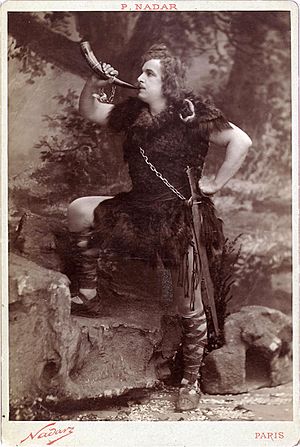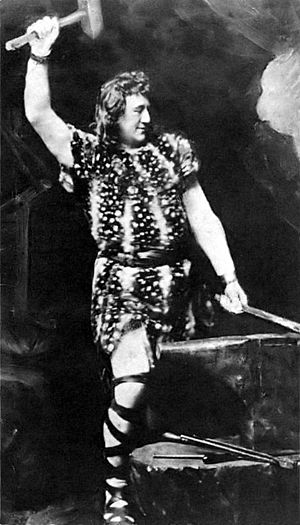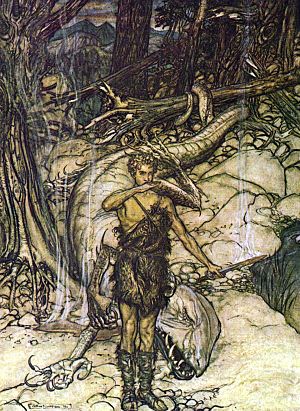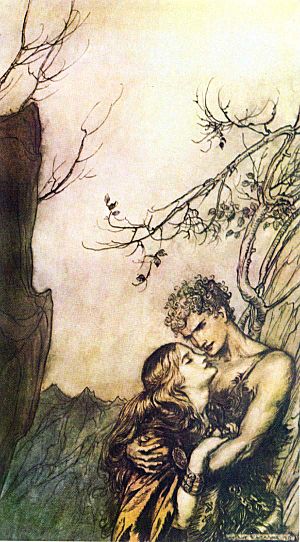Siegfried (opera) facts for kids
Quick facts for kids Siegfried |
|
|---|---|
| by Richard Wagner | |

Jean de Reszke as Siegfried (c. 1896)
|
|
| Librettist | Richard Wagner |
| Language | German |
| Premiere | 16 August 1876: Bayreuth Festspielhaus |
Siegfried is a famous opera created by Richard Wagner. It's the third part of a big story told in four operas, all together called Der Ring des Nibelungen (which means The Ring of the Nibelung). This opera continues the exciting tale right after the second opera, Die Walküre.
The very first time Siegfried was performed was on August 16, 1876. It happened at the Festspielhaus in Bayreuth, Germany, as part of the complete Ring cycle.
Contents
The Story of Siegfried's Adventure
Act One: Forging a Mighty Sword
The first part of the opera takes place in a deep forest. Here lives the huge giant Fafner. He used a magic helmet called the tarn helmet to turn himself into a scary dragon. He guards a huge treasure of gold and a powerful ring. (You can find out how he got this treasure in the first opera, Das Rheingold).
Siegfried is a young, strong boy. He wasn't born yet at the end of Die Walküre. He was raised by a mean dwarf named Mime. Mime is the brother of Alberich, another tricky dwarf from the first opera.
Mime is busy hammering at his anvil. He's trying to fix a special sword that was broken into pieces by the god Wotan. Mime wants to make the sword strong again. But every time he thinks it's ready, Siegfried easily breaks it with his bare hands.
Mime wants to give the sword to Siegfried. He plans for Siegfried to fight the dragon. Then, Mime hopes to trick Siegfried and steal the magic ring for himself. This ring would give him power over the whole world.
When Siegfried comes in, he brings a wild bear from the forest! The bear chases Mime, and Siegfried laughs. Then he lets the bear go free.
Mime tries to make Siegfried feel thankful for raising him. But Mime has never told Siegfried who his real parents were. (They were Siegmund and Sieglinde, who are now gone). Siegfried doesn't understand how babies are born. He has never even seen a woman before. He only knows Mime, who pretends to be his father.
Siegfried notices that young birds look like their parents. He asks Mime why he doesn't look like him. Finally, Mime has to tell Siegfried about his real parents and the broken sword. Siegfried tells Mime to fix the sword so he can kill the dragon. Siegfried then leaves.
Suddenly, Wotan, the chief god, appears. He is dressed as a wanderer. Mime says he will ask Wotan three questions. If Wotan can't answer, Mime will chop off his head! Wotan agrees.
First, Mime asks the name of the people who live under the earth. Wotan says they are the Nibelungs. Next, Mime asks who lives on the earth’s surface. Wotan says they are the giants. Then, Mime asks who lives in the sky. Wotan says they are the gods. Wotan has answered all three questions correctly.
Now, Wotan says it's his turn to ask Mime three questions. Mime must answer them to keep his head. Mime is very scared but agrees.
First, Wotan asks who are the people Wotan loves, even though he has to be strict with them. Mime answers: the Wälsung race. Then, Wotan asks the name of the sword Wotan left for Siegfried. Mime answers: Nothung. Finally, Wotan asks who can put the pieces of the sword back together. Mime is terrified because he doesn't know the answer!
Wotan tells him the answer: it's the person who does not know fear. He tells Mime that he can keep his head for now. He says the fearless person will be the one to chop it off later.
When Mime and Siegfried are together again, Mime tries to scare Siegfried. He wants Siegfried to learn what fear is. He tells him all about the huge dragon in the cave. "Does that not frighten you?" he asks. "Not at all!" answers Siegfried, who likes the idea of fighting a dragon.
Siegfried works at the anvil and starts to make the sword himself. Mime is thinking about how he will trick Siegfried after the dragon is killed. He plans to get the ring and kill Siegfried. At last, Siegfried finishes making the mighty sword. He shouts its name: "Nothung!" Then he crashes the sword down on the anvil, splitting it into two pieces.
Act Two: The Dragon and the Talking Bird
Outside the dragon’s cave, Wotan (still disguised) meets Alberich, Mime’s brother. Alberich hates Wotan for taking the ring from him. Wotan doesn't care. He even wakes up the dragon, but the dragon doesn't want to fight them.
Mime and Siegfried arrive. Siegfried isn't scared at all. He just wants to know where the dragon’s heart is so he can kill it. Mime leaves him alone. Siegfried sits in the forest and thinks. He's happy to know that the ugly Mime is not his father.
He hears a bird singing. He tries to copy the bird’s song with a pipe he made from a reed. Then he blows his horn, and the dragon appears! Siegfried plunges his sword into the dragon’s heart.
Siegfried instinctively puts his hand in the dragon’s mouth and tastes its blood. Suddenly, he can understand what the bird is saying! The bird tells him to take the ring and the tarn helmet. He takes them.
Mime and Alberich appear. They are arguing about who will get the ring and the tarn helmet. Siegfried appears with both. Mime offers Siegfried a drink that is drugged. The bird warns Siegfried not to drink it. Siegfried then kills Mime by chopping off his head with the sword.
The bird then tells Siegfried about a beautiful woman named Brünnhilde. She is lying on a rock, protected by a ring of fire. She is waiting for him to rescue her.
Act Three: Finding Brünnhilde
Erda, the wise Earth Goddess, talks to Wotan. She tells him about the Norns, who are weaving the rope of destiny. She is surprised Wotan punished Brünnhilde. Wotan says he now looks forward to the end of the gods. He wants Siegfried to take his place.
Siegfried arrives. He tells Wotan (who is a stranger to him) about his brave fight with the dragon. He finds Wotan annoying and smashes Wotan’s spear. He then goes to the rock where Brünnhilde is sleeping.
Siegfried bravely walks through the flames. He finds the sleeping Brünnhilde. He gently takes off her helmet, then her breastplate. He sees that she is a woman. He has never seen a woman before. For the first time in his life, he feels scared, but he really wants to wake her up.
He gently kisses her lips, and she opens her eyes and sits up. She tells him she has always loved him, even before he was born. Siegfried feels a strong connection and tries to put his arms around her. Now, Brünnhilde feels a bit scared. She asks him to keep their love pure and special. Finally, they embrace.
The Music of Siegfried
It took Wagner more than 15 years to write this opera! This is why the music in Act Three feels a little different. Some of the love music for Siegfried and Brünnhilde was later used by Wagner in a separate piece called the Siegfried Idyll.
Many of the leitmotifs (special musical ideas that represent characters or feelings) were heard in Das Rheingold or Die Walküre. One unusual instrument in the orchestra is the anvil. It's played when Mime, and later Siegfried, are hammering the sword pieces together. The beat of this music is the same as the Nibelung scene in Das Rheingold.
When Wagner first started writing, he called the opera Der junge Siegfried (The young Siegfried). But by 1856, he changed the title to Siegfried.
The German word “Sieg” means “victory,” and “Fried” or “Friede” means “peace.” It's a great name for a hero! The role of Siegfried is sung by a tenor. The singer needs a very strong voice, often called a “Heldentenor” in German (a “heroic tenor”). Siegfried is on stage for most of the opera, which lasts about four hours.
Other Operas in the Ring Cycle
- The first opera is Das Rheingold.
- The second opera is Die Walküre.
- The fourth opera is Götterdämmerung.
- The whole story is called Der Ring des Nibelungen.
- You can also learn about Siegfried (the character from Norse mythology).
See also
 In Spanish: Sigfrido (ópera) para niños
In Spanish: Sigfrido (ópera) para niños




